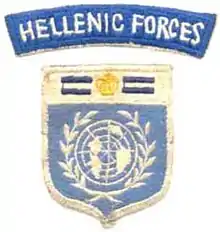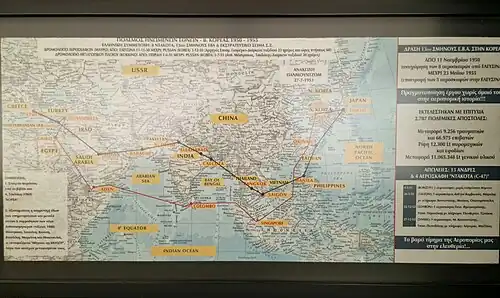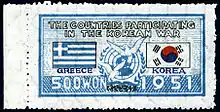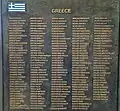Greek Expeditionary Force (Korea)
The Greek Expeditionary Force (GEF) in Korea (Greek: Εκστρατευτικόν Σώμα Ελλάδος; romanized: Ekstrateftikon Soma Ellados, abbreviated ΕΚΣΕ) was formed in response to the United Nations appeal for assistance in the Korean War. It comprised a reinforced Hellenic Army (HA) infantry battalion and the Royal Hellenic Air Force (RHAF) 13th flight of seven transport planes (C-47). Greece originally intended to send a brigade to Korea; upon consultation with the US, however, the expeditionary force was downgraded to a battalion attached to the US 1st Cavalry Division. The 13th Flight supported the US marine division and played an important role of evacuating the dead and the wounded. After the armistice, the RHAF unit withdrew in May 1955 and the HA unit in December 1955. Greece was the fifth largest troop contributor to U.N. Forces in Korea.[3]
| Greek Expeditionary Force in Korea Εκστρατευτικόν Σώμα Ελλάδος στην Κορέα | |
|---|---|
 Shoulder patch of the GEF | |
| Active | November 1950 – May 1958 |
| Country | |
| Allegiance | |
| Branch | |
| Type | Reinforced Infantry battalion, later regiment Transport aircraft flight |
| Part of | 15th Infantry Regiment US 1st Cavalry Division US 3rd Infantry Division |
| Engagements | Korean War |
| Decorations | |
| Commanders | |
| Notable commanders | Brig. Gen. Ioannis Dascalopoulos[1] Lt. Col. Dionysios Arbouzis[2] Lt. Col. Georgios Koumanakos Sq.Ldr. Georgios Pleionis |
The Greek forces brought valuable combat experience from their war against communist guerrillas in Greece (see Greek Civil War) and they were also skilled in using American weapons. Because of the mountainous terrain in their homeland, they easily acclimated to the Korean topography.[4]
A total of 10,255 Greek personnel sent to Korea.[5] 186 or 187 were killed in action and 617 wounded in action.[5] The bodies of all killed Greek soldiers had been returned back to Greece.

RHAF Transport Flight
The seven C-47s of 13th Flight, with 67 Air Force officers and personnel, departed from Elefsis air base at 08:30 on November 11, 1950. They belonged to the 355 Transport Squadron, known for its participation in the recent civil war. The majority of the officers and NCOs of this first mission were experienced airmen, being veterans of the Mediterranean and Middle East Theatre of World War II and the Greek Civil War.
On December 1, 1950, they arrived in Japan and immediately attached to the 21st Troop Carrier Sqn. (later renamed 6461 TC Sqn.) of the 374th Wing, United States Air Force, based initially at Daegu, helping at the Battle of Chosin Reservoir.
From May 14, 1951, the flight was based at Kimpo air base where it remained until May 23, 1955. During its time in Korea, the Greek Flight carried out 2,916 missions, comprising air evacuations, the transport of personnel and prisoners, drops of supplies and ammunition, the replenishment of allied bases and the collection of operational information. In total, its planes carried 70,568 passengers, including 9,243 wounded. It logged 13,777 flight hours. Losses included 12 officers and NCOs and two C-47s.
Sparta Battalion
The Greek government originally intended to send a brigade to Korea, but with quick UN victories in the autumn of 1950, the expeditionary force was downgraded to a battalion.[6] The army unit, called the Sparta Battalion, arrived in Busan on December 9, 1950 after a long voyage under Spartan Lieutenant Colonel Georgios Koumanakos, was composed of 849 men and six vehicles in an HQ company and three rifle companies; with one machine gun/mortar platoon and three rifle platoons in each. The men were all volunteers from the 1st, 8th and 9th Infantry Divisions.[7] The unit's officers were selected based on their fluency in English.[4]

From August 23, 1951, the component was expanded to 1,063 men, at which strength it remained until the December 1953 armistice. It was subsequently increased to the level of 2,163 men until April 1955. After the anti-Greek Istanbul Pogrom, in September 1955, relations with Greece's NATO ally, Turkey, deteriorated and Athens decided to recall its units stationed in Korea.[8] As a result, only 191 men were still in the country by December 1955. A representative section of one officer and nine men remained until May 1958.
Battalion events timeline
- 1950
- November 15: Embarkation at Piraeus.
- December 9: Arrival at Busan.[9]
- December 16: Move to Suwon, attached to the US 1st Cavalry Division as the "4th Battalion (GEF), 7th Cavalry Regiment".[7]
- 1951
- January 16: Remnants sweeping operation at Wolaksan, Haseoksan, Munsusan and Sinseol summits.
- January 29: Battle with 3,000 Chinese at Hill 381, west of Icheon.[6]
- February 8: Battle with the Chinese Army at Hill 489, north of Gonjiam-ri.
- March 7: Attack on Hill 326, east of Yongdu-ri.
- April 7: Advance to Geumhaksan, north of Hongchen.
- April 27: Defence of Hongje-dong area of Seoul.
- May 26: Advance to Imjingang via Nogosan and Gamaksan.
- June 9: Advance to Wyoming line, north of Yeoncheon.
- August 4: Battle with the Chinese Army near Churadong area.
- September 26: Attack against the Chinese Army at the Big Nori Hill.
- October 3–10: Battle with the Chinese Army at Hill 313 ("Scotch Hill"). The hill was captured on 5 October 5, with 28 KIA.[7]
- December 30: Deployed at Imjingang S-curved area.
- 1952
- January: patrol duties attached to the 15th Infantry Regiment, US 3rd Infantry Division.[7]
- March 17: Battle over Kelly, Nori, Betty outposts.
- May 23: The 1st company guards Kohe-do island prisoner camp.[7]
- July 23: Advance to Imjingang S-curved area again after improving the corps for four months.
- August 7: Surprise attack on Hill 167 near Imjingang.
- September 28: Battle with the Chinese Army near Nori Hill area.
- October 29: Return to the US 9th corps, move to Cheolwon area.
- December 14: Entice and destroy one Chinese company at Yujeong-ri.
- December 27: 14 soldiers killed in a transport aircraft crash in Jinhae.
- 1953
- March 11: Battle between reconnaissance squads at Hill 438.
- May 16: Deployed at Junggasan, north eastern sides of Cheolwon.
- June 16: Battle with the Chinese Army at Hill 420 (Outpost Harry).
- July 16: Battle with the Chinese Army at Hill 495, south of Bukjeon-hyeon.
- July 25: Battle with the Chinese Army at Hill 492, north of Seungam-ri.
Uniform of the Greek army force
.jpg.webp) Uniform of the Greek expeditionary force uniform on display in the Athens War Museum
Uniform of the Greek expeditionary force uniform on display in the Athens War Museum Uniform of the Greek expeditionary force on display in the War Memorial of Korea, Seoul
Uniform of the Greek expeditionary force on display in the War Memorial of Korea, Seoul First Lieutenant uniform of the Greek expeditionary force on display in the Athens War Museum
First Lieutenant uniform of the Greek expeditionary force on display in the Athens War Museum
Awards and recognitions

The 13th Flight received a US Presidential Unit Citation for its participation in the evacuation of US Marines at Hagaru-ri in December 1950.[6] The GEF Spartan battalion received its first US Presidential Unit Citation in February 1952 for the capture of Scotch Hill.
The Greek infantry company involved in the defense of Outpost Harry received the following Presidential Unit Citation:
"DEPARTMENT OF THE ARMY Washington D. C., 10 March 1955 GENERAL ORDERS 18
DISTINGUISHED UNIT CITATION Company P Greek Expeditionary Forces Battalion (Second Award) is cited for extraordinary heroism and outstanding performance of duty in action against an armed enemy in the vicinity of Surang-Ni, Korea during the period 17 June to 18 June 1953. Assigned the defense of a vital outpost position (Harry), the company encountered a major enemy assault on the evening of June 17. After an intense concentration of enemy mortar and artillery fire, the hostile forces, which had taken up an attack position on the northeast and northwest side of the outpost, moved rapidly through their own and friendly artillery fire to gain a foothold on the northern slope of the position. Refusing to withdraw, Company P closed in and met the attackers in a furious hand-to-hand struggle in which many of the enemy were driven off. The aggressors regrouped, quickly attacked a second time, and again gained the friendly trenches. Immediately, the Greek Forces launched a series of counterattacks, simultaneously dispatching a diversionary force to the east of the outpost which successfully channeled the enemy thrusts. After 2 hours of close-in fighting, the aggressors were again routed and the friendly positions restored. The outstanding conduct and exemplary courage exhibited by members of Company P, Greek Expeditionary Forces Battalion, reflects great credit on themselves and are in keeping with the finest traditions of the military service and the Kingdom of Greece."
Individual Greeks received six U.S. Distinguished Service Crosses, 32 Silver Stars, 110 Bronze Stars. 19 members of 13th Flight received the US Air Force Air Medal for the Hagaru-ri evacuation operation in December 1950. The Greek battalion's war flag also received the highest Greek military decoration, the Commander's Cross of the Cross of Valour, in 1954.
Helping Korean civilians
The Greeks were interested in the welfare of Korean civilians. They especially treated Korean children with great kindness including the feeding, clothing and sheltering of Korean orphans, possibly because of the kidnapping of Greek children by Communists during the Greek civil war.[10]
Religious work in South Korea
Greek military chaplains played a prime role in the preservation of the Korean Orthodox Church during the Korean War. This small religious body, founded by Russian Orthodox missionaries during the czarist era, had suffered persecution due to a series of historical developments -- the Japanese colonization of Korea, the rise of communism in Russia, World War II and the division of the Korean Peninsula. The Korean War added to the devastation. When Greek chaplains became aware of the Korean church, its flock had been scattered and its clergy were dead or presumed dead. The Greeks helped arrange ordination of new Korean clergy and eventually helped the church affiliate with an Orthodox bishop overseas. Today, the church has its own resident bishop and has thousands of members in South Korea.
Memorials and Monuments
Korea
- In 1961 Greece installed a plaque at the United Nations Memorial Cemetery in Busan. The plaque reads “From Greece for her fallen sons in gratitude”.[11] In addition, the names of the fallen Greeks are on the Wall of Remembrance and there is a plaque for Greece on the UN forces monument.
- At the UN veterans memorial in Busan, there is a Greek flag and a sculpture of a Greek soldier next to the flags and the soldiers of the other UN nations who helped South Korea.
- In 1974 South Korea raised a Greek War Memorial in Yeoju, with the names of the Greeks who were killed in the war engraved on it.[11]
- At the Korea War Memorial in Seoul, there is a monument dedicated to Greece. In addition, the names of the Greeks who killed in action during the war are on the roll of honor and there is also a commemorative stele for Greece at the “Monument for the Participants” section.[11]
- Inside the Statue of Brothers in Seoul, there is a plaque for Greece.
Greece
- On the Tomb of the Unknown Soldier in Athens the word "Korea" is engraved on the tomb in order to honor the men who were killed during the war.
- A Monument in the Athens War Museum.
In the Athens War Museum
 Monument dedicated to the Greek Force in the Athens War Museum
Monument dedicated to the Greek Force in the Athens War Museum
In the War Memorial of Korea at Seoul
 Greece monument at the War Memorial of Korea
Greece monument at the War Memorial of Korea Part of Greece's monument at the War Memorial of Korea
Part of Greece's monument at the War Memorial of Korea Names of the Greeks who killed at the Korean War in the War Memorial of Korea
Names of the Greeks who killed at the Korean War in the War Memorial of Korea Greece stele at the War Memorial of Korea
Greece stele at the War Memorial of Korea Greece plaque inside the Statue of Brothers
Greece plaque inside the Statue of Brothers
In the UN Memorial Cemetery at Busan
 Greece memorial in the United Nations Memorial Cemetery
Greece memorial in the United Nations Memorial Cemetery Names of the fallen Greeks on the Wall of Remembrance at the United Nations Memorial Cemetery
Names of the fallen Greeks on the Wall of Remembrance at the United Nations Memorial Cemetery Names of the fallen Greeks on the Wall of Remembrance at the United Nations Memorial Cemetery
Names of the fallen Greeks on the Wall of Remembrance at the United Nations Memorial Cemetery
In the popular culture
The American feature film The Glory Brigade deals with the mission of the Greek military and its joint operations with U.S. forces in the Korean War. The movie was shot in Hollywood and on location in rural Missouri in late 1952, and it was released in spring 1953, shortly before the end of the war. Film star Victor Mature plays a U.S. officer of Greek descent in the movie. Alexander Scourby, an American actor of Greek heritage, plays a Greek officer.
References
- "Korean War Educator: Topics - National Archives Records - RIP 103".
- Edwards, Paul M. (2006). Korean War almanac (1. ed.). New York: Facts On File. p. 517. ISBN 978-0-8160-6037-5.
- Βασιλόπουλος (Vasilopoulos), Χρήστος (Christos) (2007). "Οι Έλληνες στον πόλεμο της Κορέας" [Greeks in Korean War]. Η Μηχανή Του Χρόνου (The Time Machine) (in Greek and English). Greece. Event occurs at 6:47. Alpha TV.
- Stanley Sandler (1995). The Korean War: An Encyclopedia. Routledge. p. 125. ISBN 978-0824044459.
- Info from the War Memorial of Korea at South Korea
- Sandler (1995), pp. 136–138
- Thomas, Abbott & Chappell (1986), pp. 22–23
- Xydis, Stephen George (1967). Ohio State University Press. Ohio State University Press. p. 161.
- Edwards (2000), p. 118
- Stanley Sandler (1995). The Korean War: An Encyclopedia. Routledge. pp. 125–126. ISBN 978-0824044459.
- Monuments in the Republic of Korea commemorating the participation of the Greek Expeditionary Corps in the Korean War
Further reading
- The History of the UN Forces in the Korean War-3 (Belgium, Colombia, France, Greece, Luxembourg, Netherlands, Denmark, Italy, Norway, Sweden) - ROK Ministry of National Defense Institute for Military History, 1974 (E-BOOK) Archived 2023-07-09 at the Wayback Machine
- The History of the UN Forces in the Korean War-3 (Belgium, Colombia, France, Greece, Luxembourg, Netherlands, Denmark, Italy, Norway, Sweden) - ROK Ministry of National Defense Institute for Military History, 1974 (PDF) Archived 2023-06-05 at the Wayback Machine
- The History of the UN Forces in the Korean War-6 (Summary) - ROK Ministry of National Defense Institute for Military History, 1977 (E-BOOK) Archived 2023-07-09 at the Wayback Machine
- The History of the UN Forces in the Korean War-6 (Summary) - ROK Ministry of National Defense Institute for Military History, 1977 (PDF) Archived 2023-06-28 at the Wayback Machine
- The Korean War and the UN Forces - ROK Ministry of National Defense Institute for Military History, 2015 (E-BOOK) Archived 2023-07-09 at the Wayback Machine (in Korean)
- The Korean War and the UN Forces - ROK Ministry of National Defense Institute for Military History, 2015 (PDF) Archived 2023-07-09 at the Wayback Machine (in Korean)
- The Statistics of the Korean War - ROK Ministry of National Defense Institute for Military History, 2014 (E-BOOK) Archived 2023-07-09 at the Wayback Machine (in Korean)
- The Statistics of the Korean War - ROK Ministry of National Defense Institute for Military History, 2014 (PDF) Archived 2021-01-11 at the Wayback Machine (in Korean)
- The History of the UN Forces in the Korean War - ROK Ministry of National Defense Institute for Military History, 1998 (E-BOOK) Archived 2023-07-09 at the Wayback Machine (in Korean)
- The History of the UN Forces in the Korean War - ROK Ministry of National Defense Institute for Military History, 1998 (PDF) Archived 2023-07-09 at the Wayback Machine (in Korean)
- The Summary of the Korean War - ROK Ministry of National Defense Institute for Military History, 1986 (PDF) Archived 2023-07-09 at the Wayback Machine (in Korean)
- The History of the Korean War-10: The UN Forces (Australia, Belgium, Luxembourg, Canada, Colombia, Ethiopia, France, Greece, Netherlands) - ROK Ministry of National Defense Institute for Military History, 1980 (E-BOOK) Archived 2023-06-24 at the Wayback Machine (in Korean)
- The History of the Korean War-10: The UN Forces (Australia, Belgium, Luxembourg, Canada, Colombia, Ethiopia, France, Greece, Netherlands) - ROK Ministry of National Defense Institute for Military History, 1980 (PDF) Archived 2023-06-05 at the Wayback Machine (in Korean)
- Vakalopoulos, George (1974). Κορέα αποστολή 13η: εντυπώσεις ενός αυτόπτη [Korea mission 13: an eyewitness] (in Greek).
- Thomas, Nigel; Abbott, Peter; Chappell, Mike (1986). The Korean War 1950–53. Osprey Publications. ISBN 0-85045-685-1.
- Sandler, Stanley (1995). The Korean War: An Encyclopedia. Taylor & Francis. ISBN 0-8240-4445-2.
- Edwards, Paul M. (2000). To Acknowledge a War: The Korean War in American Memory. Greenwood Publishing Group. ISBN 0-313-31021-1.
- Pagomenos, George; Kazamias, G.A.; Stephanides, Giannis (2004). Το Ημερολόγιο ενός Έλληνα Στρατώτη στον Πόλεμο της Κορέας [The Diary of a Greek Soldier in the Korean War] (in Greek). Μεσόγειος. ISBN 960-406-928-4. Archived from the original on 2008-10-25.
- Αβτζιγιάννης, Κωνσταντίνος (2005). Η Ελλάδα στον πόλεμο της Κορέας [Greece in Korean War] (in Greek). ΕΠΙΚΟΙΝΩΝΙΕΣ Α.Ε.
- Papadakis, P.V., (Ed.) (2005). Ελληνικα Φτερα στον Πολεμο της Κορεας [Greek Wings in the Korean War] (PDF) (in Greek). Air Force General Staff – History Service. ISBN 960-87026-2-3. Archived from the original (PDF) on 2015-06-28. Retrieved 2008-06-05.
{{cite book}}: CS1 maint: multiple names: authors list (link) - Sŏ, Sŏk-pong (2006). Descendants of Athene: a history of Greek soldiers' participation in the Korean War. Seoul: Ministry of Patriots' and Veterans' Affairs. OCLC 243709579.
- Smokovitis, Dimitrios (2009). "Greece's contribution to the Korean War (1950–1955)". In Caforio, Giuseppe (ed.). Advances in Military Sociology: Essays in Honor of Charles C. Moskos (Chapter Item). Contributions to Conflict Management, Peace Economics and Development. Vol. 12A. Emerald Group Publishing Limited. pp. 225–232. doi:10.1108/S1572-8323(2009)000012A015. ISBN 978-1-84855-890-8.
External links
- Outpost Harry Project
- Outpost Harry Survivors Association
- History War Museum - UNITED NATIONS ARMY, GREEK EXPEDITIONARY FORCE IN KOREA
- Article on 13th Transport Flight from the official Hellenic Air Force website (in Greek)
- Royal Hellenic (Greek) Forces
- The 13th Flight of the RHAF in Korea
- The 60th Anniversary Of The Korean War Commemoration Committee
- The Monument for the Participation of Greece in the Korean War
- Heroes of the Korean War: Lieutenant Colonel George Koumanakos (part 1) Archived 2013-01-19 at the Wayback Machine
- Heroes of the Korean War: Lieutenant Colonel George Koumanakos (part 2) Archived 2013-03-16 at the Wayback Machine
- A brief history of the Greek Expeditionary Force from the Greek Army (in Greek)
- Korea (November 1950-May 1958) (in Greek)
- The Greek Expeditionary Force in Korea 1950-1955 (in Greek)
Videos
- Βασιλόπουλος (Vasilopoulos), Χρίστος (Christos) (2007). "Οι Έλληνες στον πόλεμο της Κορέας" [Greeks in Korean War]. Μηχανή Του Χρόνου (The Time Machine) (in Greek). Greece. Alpha TV.
- Βασιλόπουλος (Vasilopoulos), Χρίστος (Christos). "Ο Πόλεμος της Κορέας Μέρος Α" [Korean War Part A]. Μηχανή Του Χρόνου (The Time Machine) (in Greek). Greece. Cosmote.
- Βασιλόπουλος (Vasilopoulos), Χρίστος (Christos). "Ο Πόλεμος της Κορέας Μέρος Β" [Korean War Part B]. Μηχανή Του Χρόνου (The Time Machine) (in Greek). Greece. Cosmote.
- "Η Ελλάδα στον Ψυχρό Πόλεμο 1950-1980" [Greece during the Cold War 1950-1980]. Εμείς οι Έλληνες (The Greeks). Episode 12 (in Greek). Greece. 2008. Skai TV.
- Outpost Harry. Archangel Films. Refer to Greeks from 6:42.
- U.N. Greek Battalion In Korea from the British Pathé
- Greek Troops For Korea from the Associated Press
